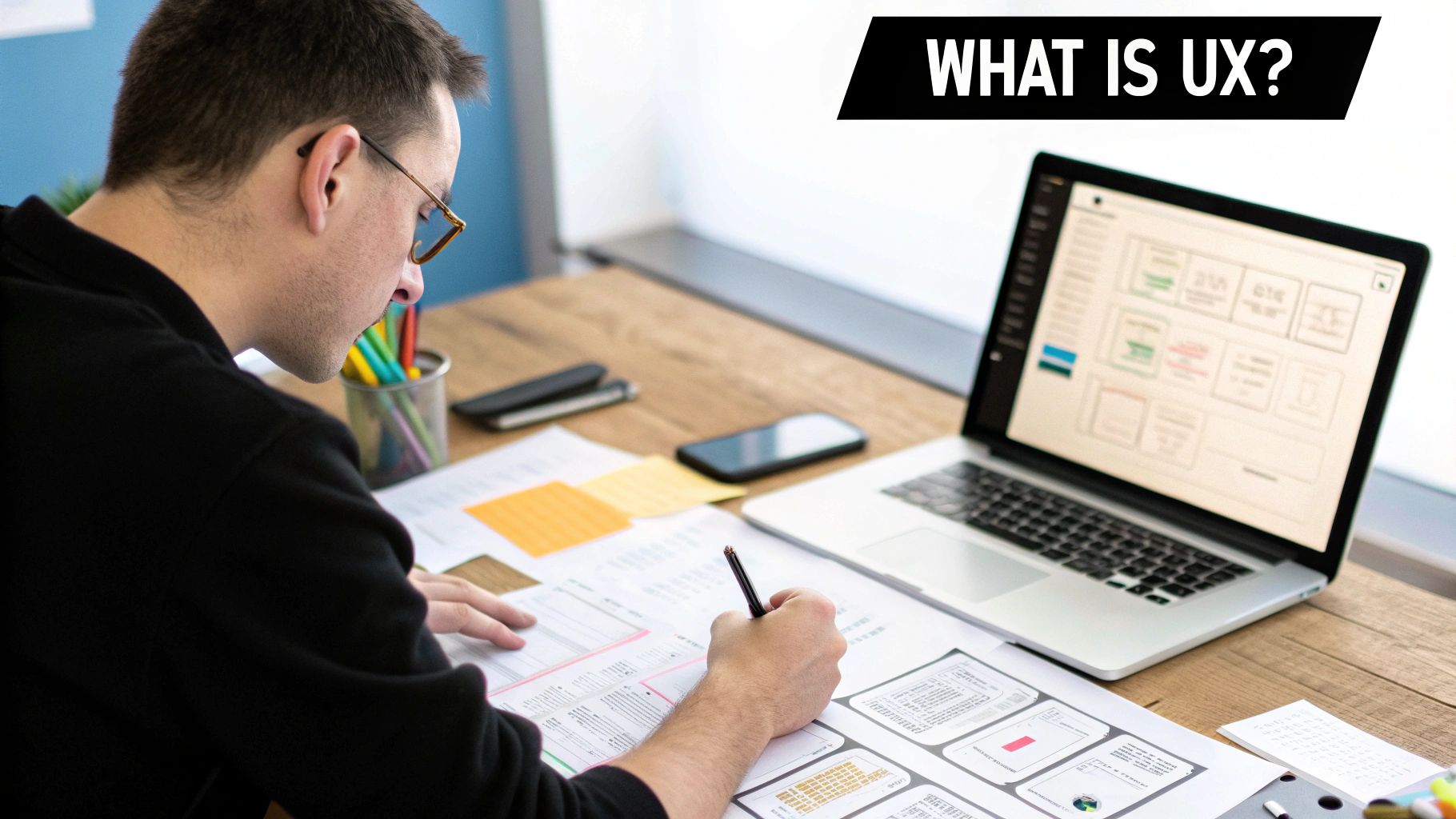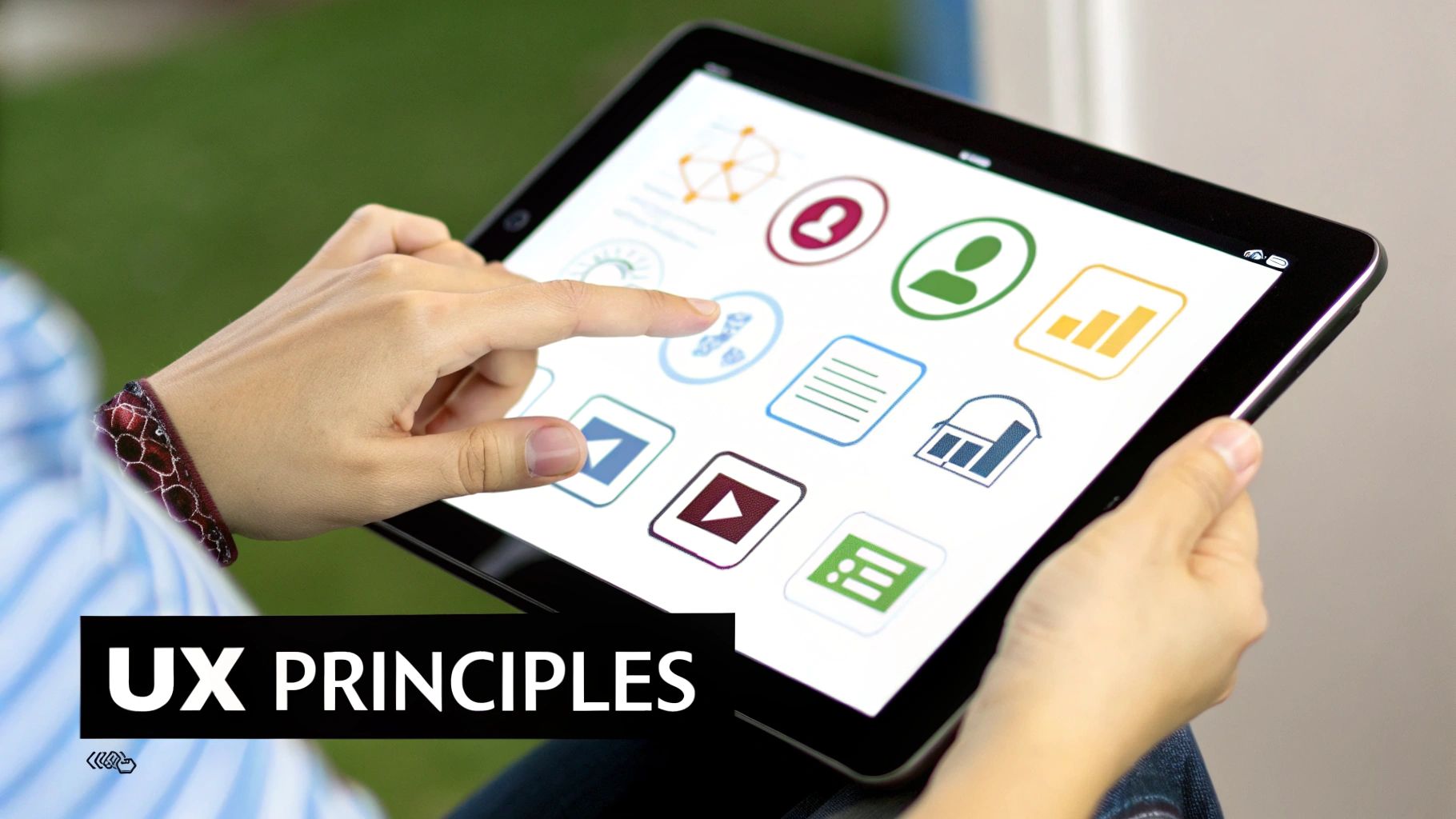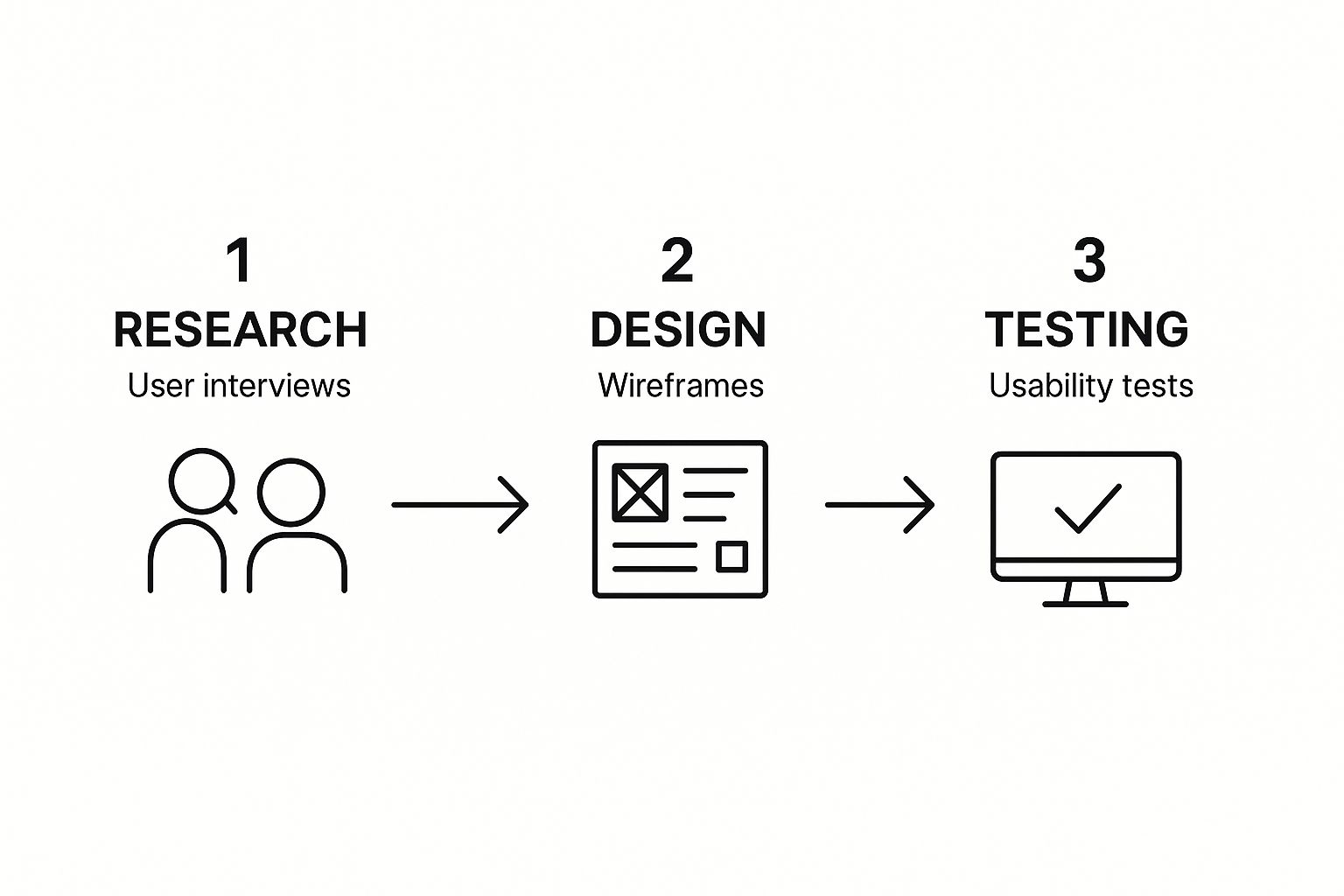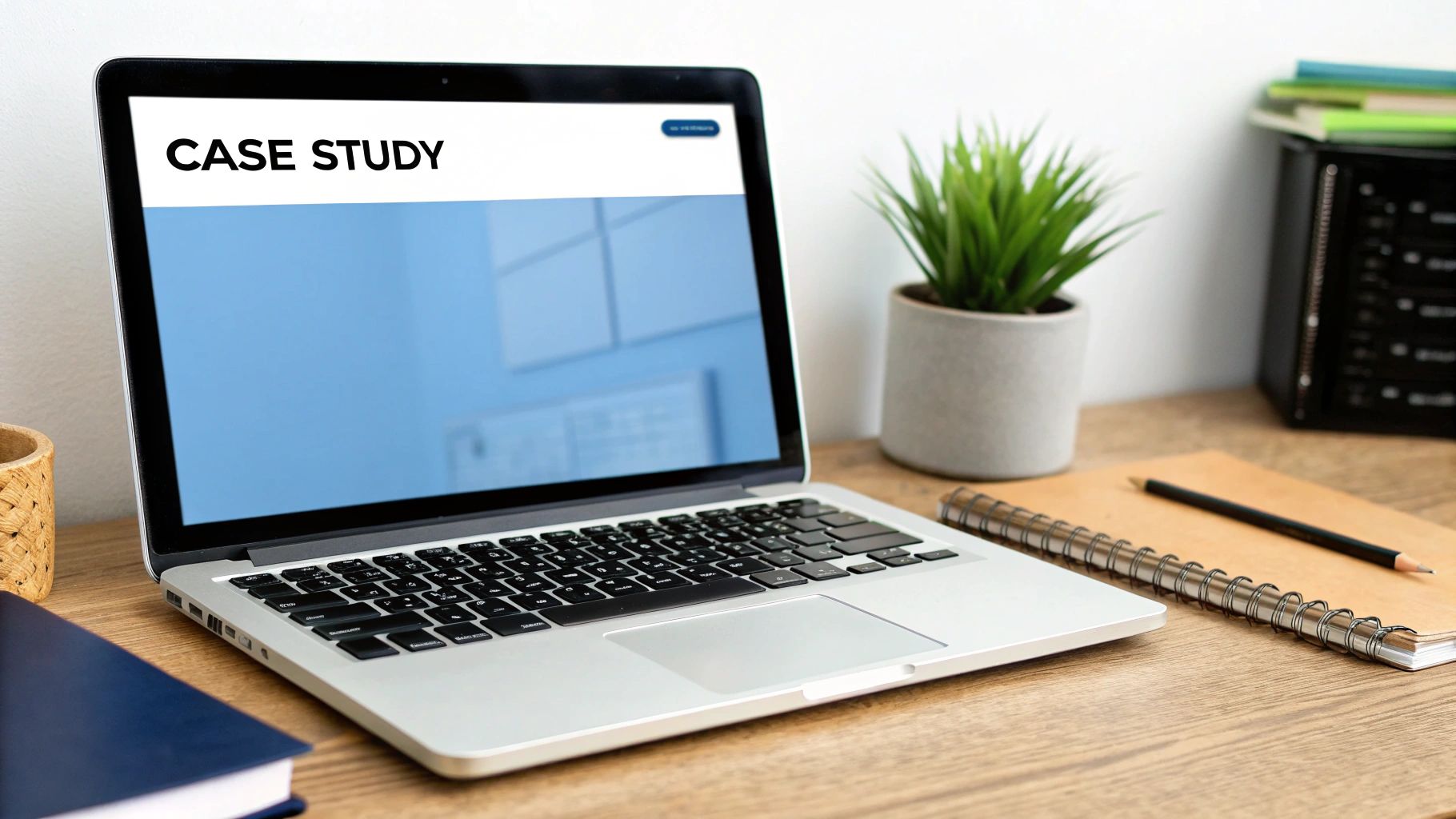At its core, user experience (UX) design is all about making technology feel human. It’s the art and science of ensuring that when someone interacts with a digital product, the entire process feels intuitive, efficient, and perhaps even a little delightful.
What Exactly is User Experience Design?

Think of it as the invisible blueprint for a digital product. It is not just about the visuals; it’s about the entire journey a person takes from start to finish. A truly great UX seems to predict what you need, guiding you through a task so effortlessly that you barely notice the design at all.
Take a well-made mobile banking app, for example. You can check your balance, transfer funds, or pay a bill with just a few simple taps. The whole process feels so natural, so obvious, that you do not give it a second thought. That feeling of simplicity is no accident—it is the direct result of careful, thoughtful UX work.
Untangling UX from UI
You will often hear UX mentioned in the same breath as User Interface (UI) design, and while they are teammates, they have very different jobs. Understanding the distinction is key to appreciating how great digital products are built.
UX is the whole experience—the journey and the feeling a user gets. UI is the set of visual elements and controls they use to take that journey.
- UX Design (The Journey): This is the big-picture strategy. It is focused on the product's usability, accessibility, and the overall satisfaction it delivers. It answers the question, "Is this product easy and enjoyable to use?"
- UI Design (The Controls): This is the visual and interactive part. It covers everything you can see and touch: the buttons you click, the text you read, the images, sliders, and entry fields.
Here’s an analogy: if a product were a car, the UI designer would craft the dashboard—the look of the speedometer, the shape of the buttons, the feel of the dials. The UX designer, on the other hand, ensures the entire experience of driving that car, from adjusting your seat to checking your blind spot, is logical, comfortable, and safe.
This difference is not just academic; it has real business consequences, particularly in Australia where customer loyalty is increasingly tied to digital interactions. In fact, 53% of Australian consumers say they would switch to a competitor if a brand’s digital experience failed to live up to their expectations. This statistic makes it crystal clear: a smooth, user-focused journey is not just a nice-to-have, it is a must-have. You can dive deeper into these customer experience trends in Australia to see just how important this has become.
The Pillars of Exceptional UX Design

A truly great user experience does not just happen by chance. It is the result of a deliberate, thoughtful process built on a few core principles. Think of these as the foundational pillars that support any product worth using, ensuring it is not just functional, but genuinely effective and even enjoyable.
At its core, every product has to be usable. Usability is the most practical of these pillars: can someone actually use your product easily? If a new user can download your app and achieve their goal without hitting a wall of confusion, you are on the right track. It is all about efficiency, clarity, and designing a path so logical it feels almost invisible.
Imagine the smooth, one-click checkout on your favourite online store. That did not happen by accident. It is the result of countless hours spent refining the process to make it as effortless as possible for you.
Making Technology Work for Everyone
Next is accessibility, which is all about making sure technology is inclusive. This means designing products that can be used by people with a wide range of abilities, including those with visual, auditory, motor, or cognitive impairments. It is about leaving no one behind.
For instance, good accessibility is what enables someone using a screen reader to navigate a government website to find critical information. It is also why designers choose high-contrast text for readability or ensure you can navigate a site without relying on colour alone.
An accessible design does not just cater to a small group; it ends up creating a better, more flexible experience for all of us. Think about captions on videos or voice commands on your phone—these were born from accessibility needs but now benefit everyone.
Creating an Experience People Love
Finally, we have desirability. This is the emotional side of UX. While the other pillars focus on function and ease, desirability is about the feeling a product gives you. It is that hard-to-define quality that makes you prefer one app over another, even if they both do the same thing.
Desirability is a blend of a few key ingredients:
- Aesthetic Appeal: A clean, visually pleasing interface that just feels right.
- Brand Connection: The design feels like it truly represents the brand, building trust and familiarity.
- Delightful Details: Those small animations, satisfying sounds, or clever interactions that bring a smile to your face.
Together, these three pillars—Usability, Accessibility, and Desirability—form the bedrock of excellent UX design. When they work in harmony, you do not just have a product; you have an experience.
Mapping The UX Design Journey
Getting from a spark of an idea to a finished digital product is not a happy accident. It is a disciplined, methodical process. User experience design is all about evidence, empathy, and iteration, turning abstract concepts into tangible, helpful solutions. This journey ensures the final product does not just function, but actually works for the people who will be using it day in and day out.
Everything kicks off with a deep dive into understanding the user. This foundational stage, user research, is where designers put their own assumptions aside and just listen. They will use techniques like one-on-one interviews, surveys, and observational studies to get to the heart of their audience's real needs, frustrations, and motivations. From this rich data, they create user personas—detailed profiles of fictional users that help the entire team build empathy and keep their focus sharp.
From Research To Reality
With a clear picture of the user in mind, the design work begins. But we are not talking about colours and fonts just yet; this part is all about structure and flow. Designers create wireframes, which are essentially basic, black-and-white layouts. These skeletal blueprints map out the product's core functions and user pathways without the distraction of visual styling. It is about getting the bones right before putting any skin on.

The image above really captures the core iterative loop of the UX process, showing how it moves from research to design and then to testing. Each stage flows into the next, creating a cycle of continuous improvement that is powered by user feedback. To keep this complex journey on track, designers often rely on solid project management. You can explore project management best practices for designers to get a better handle on these workflows.
Once the blueprint is solid, designers build interactive prototypes. Think of these as clickable mock-ups that simulate the final product, allowing for realistic testing long before a single line of code is written.
The goal of prototyping is simple: fail early and fail cheaply. It is far more efficient to discover a flaw in a mock-up than in a fully developed application.
The last crucial step is user testing. This is where real users get their hands on the prototype while designers observe. Their honest feedback—the frustrations, the 'aha!' moments, the confusion—provides priceless insights that fuel the next round of refinements. This cycle of building, testing, and learning is what truly defines the UX design journey.
To give you a clearer picture, here is a quick breakdown of the typical phases involved in the UX design process.
Key Phases of the UX Design Process
| Phase | Primary Goal | Example Activities |
|---|---|---|
| 1. Research & Discovery | Understand user needs, behaviours, and business context. | User interviews, surveys, competitor analysis, creating user personas. |
| 2. Ideation & Design | Generate and visualise potential solutions. | Brainstorming sessions, creating user flows, sketching wireframes. |
| 3. Prototyping | Create a testable, interactive model of the product. | Building low-fidelity (basic) or high-fidelity (detailed) prototypes. |
| 4. Testing & Validation | Gather user feedback on the prototype to identify issues. | Usability testing sessions, A/B testing, feedback analysis. |
| 5. Implementation & Iteration | Work with developers to build the final product and refine it. | Design handoffs, quality assurance checks, post-launch analysis. |
Each phase builds on the last, ensuring the final product is not only functional but also genuinely valuable to the people it was designed for.
Why Great UX Is a Business Superpower
Let us be clear: exceptional user experience is not just a nice-to-have creative touch. It is a serious engine for business growth. When your design is intuitive and genuinely focused on the user, it translates directly into real commercial results, completely changing how your company performs.
Think about it this way: a smooth, effortless user journey is not a luxury anymore. It is a core asset that builds loyalty and, most importantly, drives revenue.
A positive experience directly bolsters your bottom line. When people can easily find what they are looking for and get things done without hitting a wall, they are far more likely to convert. That could be making a purchase, signing up for a newsletter, or asking for a quote. On the flip side, frustration is the quickest way to send a potential customer straight to your competitor.
Turning Clicks Into Customers
An intuitive design works like a silent salesperson, gently guiding users towards their goals and boosting your business in the process. This is especially true in Australia’s booming eCommerce space, which is on track to hit nearly AUD 50 billion by 2025.
Much of this growth is powered by UX fundamentals—things like fast load times, mobile-friendly layouts, and simple navigation. In such a crowded online market, these elements are what keep customers from bouncing. You can explore the data behind design-driven eCommerce in Australia to see just how critical this is.
But it goes beyond just sales. Great UX builds trust and nurtures powerful brand loyalty. When a product consistently delivers a positive and reliable experience, you give customers no reason to even think about looking elsewhere.
Investing in UX is not an expense; it is one of the most reliable investments a business can make. It builds a rock-solid brand reputation and creates a competitive edge that is incredibly difficult for rivals to copy.
By getting to the heart of what your users actually need, businesses can innovate far more effectively. You end up creating products and services that solve genuine, real-world problems. This user-first mindset is a cornerstone for building a lasting culture of innovation in the tech industry.
Ultimately, when you commit to superior user experience, you are committing to a healthier, more profitable business.
The Modern UX Designer's Toolkit

Knowing the principles of UX design is one thing, but bringing those ideas to life? That requires a whole different set of tools and skills. Today's UX designer operates with a specialised digital toolkit, moving through each stage of the design process from a rough idea to a polished, final interface.
Think of these digital tools as the workshop where raw concepts are moulded into intuitive, user-friendly products. In the early days of a project, when you are just sketching out the basic structure and how a user will move through an app, designers lean heavily on wireframing and prototyping software.
Industry favourites like Figma, Sketch, and Adobe XD are the go-to choices here. They give designers the power to create everything from a simple, low-fidelity wireframe to a highly detailed, interactive prototype that feels almost like the finished product. This is absolutely critical for testing ideas with real people long before a single line of code is written.
More Than Just Software
But the software is only half the story. The best UX designers I have worked with have a powerful set of soft skills that allow them to connect with users and work seamlessly with their teams. These abilities are what really separate a good designer from a great one.
The most powerful tools a UX designer has are not apps. They are empathy, clear communication, and a relentless curiosity about how people think and behave.
To genuinely see things from a user's point of view, you need a deep sense of empathy. Beyond that, being able to communicate your ideas strategically and solve problems as a team is crucial for presenting concepts, taking on feedback, and working effectively with developers and stakeholders.
Getting this mix of technical and human skills right is what sets a designer up for real success. It also keeps them ready for what is next, which you can explore further in our guide to the key digital demands and trends for 2024.
A few essential skills every UX professional needs to cultivate:
- Empathy and User Advocacy: The drive to put yourself in the user's shoes and be their voice in every meeting.
- Strategic Communication: The knack for explaining why a design choice was made, not just what it is.
- Collaborative Problem-Solving: Working hand-in-glove with engineers and product managers to find the smartest solutions.
- Analytical Thinking: Using hard data from tools like Hotjar or Google Analytics to back up and refine design instincts.
In the end, a UX designer's toolkit is not just about software licences; it is a powerful combination of technical know-how and profoundly human skills.
Common Questions About UX Design
To really get a handle on user experience design, it helps to tackle some of the questions that pop up all the time. From the outside, the field can seem a bit complicated, but its core ideas are actually quite intuitive.
UX vs. UI: What's the Difference?
One of the biggest points of confusion is the difference between UX and UI design. They are often mentioned together and work hand-in-hand, but they are two distinct disciplines.
Think of it like building a house. The UX designer is the architect who drafts the blueprint, figuring out the flow of the rooms, where the doors should go for easy access, and making sure the overall structure is functional and liveable. The UI designer is the interior designer who comes in to pick the paint colours, light fittings, and furniture.
UX is the whole experience—the logic, the structure, and the feeling that a product solves a real problem. UI is the visual layer—the buttons you tap, the icons you see, and the screens you interact with.
Basically, UX makes a product useful; UI makes it look good. You absolutely need both. A beautiful app that is impossible to use is a failure, just like a super-functional app that looks like it was designed in the 90s.
How Do You Start a Career in UX Design?
Lots of people are curious about breaking into the field. The great thing is, there is no single "right" way to do it. Many of the best designers I have met came from backgrounds in psychology, marketing, or even customer service. They bring a unique empathy for the user that you just cannot teach.
If you are starting out, the best first step is to dive in and learn the fundamentals.
- Read everything you can: Follow industry blogs and pick up classic books on usability and design thinking.
- Learn the tools of the trade: Get familiar with software like Figma or Sketch using online tutorials. There are tons of them out there.
- Start building a portfolio: You do not need a huge client to begin. Redesign a feature of an app you use daily, or offer to help a local charity. Just start applying what you have learned.
For companies, finding the right design talent is a specialised skill. Knowing the subtle differences between roles is crucial. That is why many businesses partner with an agency that has deep expertise in UX recruitment to build a team that can deliver.
Is UX Only for Big Companies?
There is this lingering idea that UX is a luxury only big corporations with deep pockets can afford. That is completely wrong. Any business, of any size, can see huge benefits from applying UX principles.
A small e-commerce startup could see a massive sales boost just by making its checkout process a little smoother based on what customers are actually doing. A local plumber can get more calls by making sure their website is easy to use on a mobile phone.
Investing in user experience is not about a massive budget. It is about a mindset shift—putting your customer at the centre of your decisions. Even tiny, smart changes based on understanding user needs can deliver a fantastic return, build loyalty, and fuel growth, no matter how big or small your company is.
At Redwolf Rosch, we specialise in connecting businesses with the top-tier IT and digital talent needed to drive their transformation forward. If you're looking for a trusted, high-performing recruitment partner to find experts in user experience design, get in touch for an introductory discussion today at https://redwolfrosch.com.au.
 Submit CV
Submit CV Submit vacancy
Submit vacancy  Call for a Candidate
Call for a Candidate